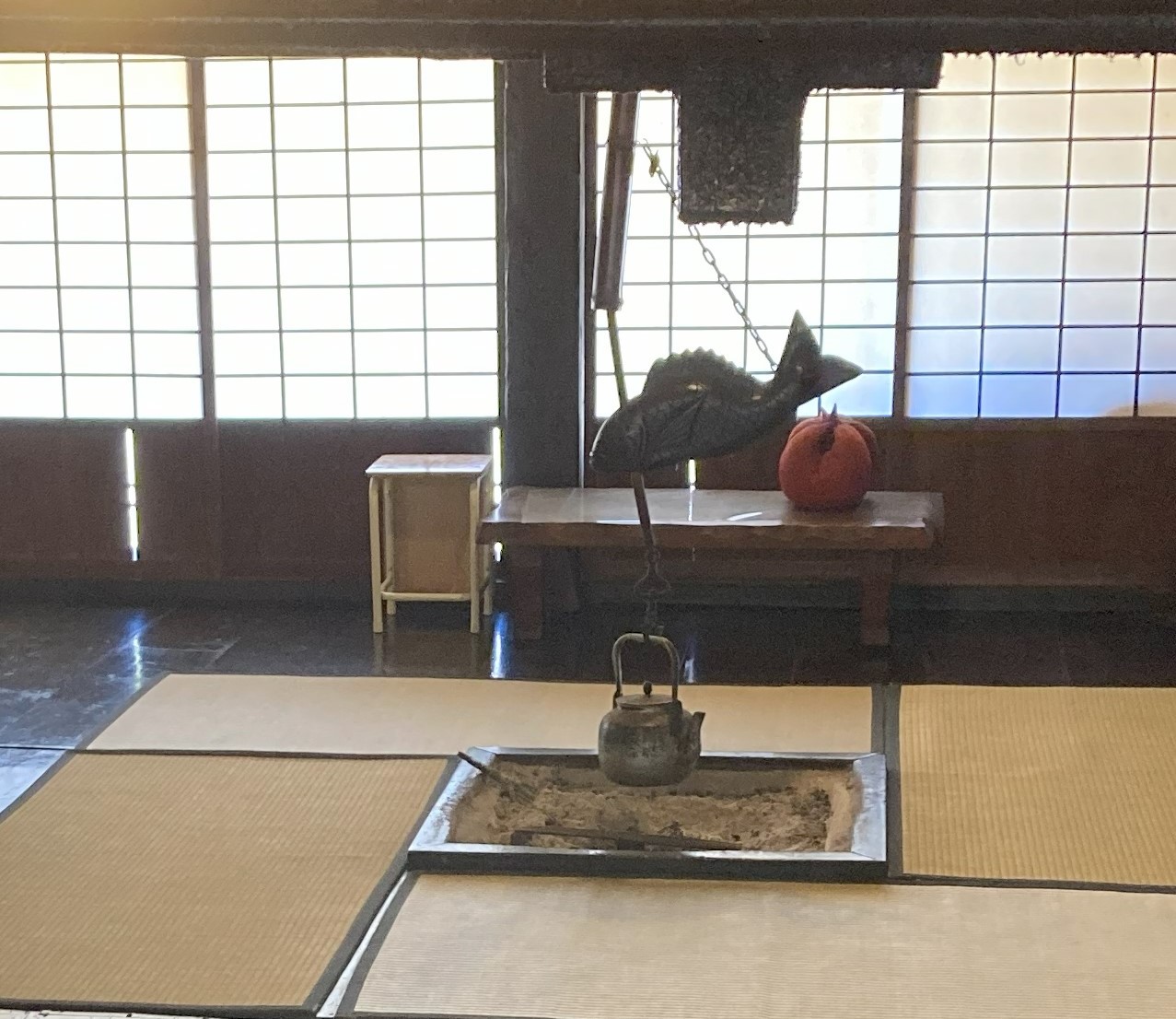本ブログは観光業、企業接待、留学生対応等で英語案内が必要ながら、多忙で準備に時間をかけられない方々の為にすぐに使える情報を分かりやすく解説しています。
今回は本編ブログ『世界遺産@白川郷わかりやすく解説』の《6 合掌造り一階(生活空間)>6.2 インバウンドの視点:笑いも取れるかも?>Q1 ここでは何人位暮らしていたのですか?》のA級者用(日→英の対応が必要な方)向け演習《Dツール》です。
👉ショートカット&リンクについて!①最初に音声で学習されたい方はそのままお進み下さい。➁最初に原文を確認されたい方は【原文:英日】へ。③本編ブログを参照されたい方は『白川郷わかりやすく解説』へ。④音声ツールの概要を参照されたい方は『演習ツール』まで!
6 合掌造り一階(生活空間)
“Gassho-zukuri ground floor (living space)”
6.2 インバウンドの視点:笑いも取れるかも?
Q1 ここでは何人位暮らしていたのですか?
“How many people lived here?”
Dツール:”日⇒英”演習簡易ツール
本ブログ同様、全17文は前半の真面目パート(1-10)と後半のおふざけパート(11-17)の2ファイル構成になっています。また日本語だけ演習向けに(不自然にならない範囲で日英の語順を合わせる様に)編集しています。
D1:日英確認用:『日本語』”英語”対訳
👉文単位で日本語の後に英訳が續きますので、内容の確認ができます。
D2:口頭即訳用:『日本語』のみ(ポーズ間に英訳)
👉各日本語文の後はポーズになっていますので、その間に英訳できます。
D3:リピーティング用:”英語”のみ(ポーズ無し)
👉英語音声のみが(ポーズなく)続きますので復唱ができます。
D4:内容チェック用:”英語”のみ(低速版:or同通演習用)
👉英語音声(ポーズなし)を低速版で復唱or同時通訳の演習ができます。速さはいつも通り、約120wpm(約85%低速版)です。
【原文:日英】
《日本語》
- 一般的に、複数の家族がそのスペースを共有していて、それで大きい家では、四十人もの人達がこの一階で暮らしていました。
- この狭い三日月形の川沿いの盆地では、分家して分ける土地がないので、たとえ結婚して家族を持っても、彼らは選択の余地なく、親の家かそれを継いだ長男と一緒に住み続けるしかないのです。
- 養蚕業は、二十四時間継続的な世話が必要となるので、求められるのは沢山の労働力なので、家族が増えるのは実務的な理由によるのです。
- ワンフロアに四十人収容するのは大変ですが、家族達は一つの部屋を多目的に使う事で上手くやり繰りしていて、例えば、居間、台所、応接室、寝室等、日本の伝統的なやり方ですね。
- 現在の世の中で暮らす我々にとっては、プライバシーが最優先で個室が普通の世界なので、この共同生活環境は驚きかもしれません。
- でもここで、我々は問題解決のヒントを見つけられるかもしれせんね、どんなに自由を謳歌していても。自由な現代生活による不可避の弊害のいくつかを少し緩和するような。
- 例えば、ここでは複数世代の家族が一緒に住んでいるので、高齢化した子供がその高齢の親を介護する手間やアパートでの孤独死、そして個室への引きこもりが事実上存在しませんでした。
- もちろん共同生活には自分だけの時間や空間を犠牲にしなければならない時も多いですが、他人のために犠牲を払うことには、本当にメリットがあるのです。
- 考えてみれば、身近な例でも良く見られましたが、人々は与えられた沢山の自由とたっぷりの自由時間を上手く使いこなせず、結局、生活も精神も荒んでしまうんです。
- むしろ、白川郷の暮らしが教えてくれるのは。ある程度の時間や空間の制約があることは、ここで体感されたように、生活のリズムや相互扶助の人間関係を育むのにメリットがあるってことです。
- ところで、四十人の家族というのは一般的な日本の小学校の1クラスの規模なので、たまに思うのが、合掌造りの家は、もしもう使わないなら、学校だけの空間として使えないかってことです。
- 一階は座学の教室として使えますし、囲炉裏部屋はリラックス用のキャンプファイヤーに、そして巨大な屋根裏は仕切られた床を取り払えば体育館になります。
- 今の日本は少子化で小学生の学校ニーズは少ないことを思うと、このような建物を増え続ける定年退職後の中高年の再就職支援プログラムに再利用するなんて、価値ある利用法かもしれません。
- 合宿型の集中コースでは、参加者は蚕を育てて二十四時間体制の労働環境でのサービス能力を磨き、コンビニ業界に再就職できる人もいるかもしれません。
- 日々多くの海外からの観光客に接することで語学研修のモチベーションがアップするかもしれません、コミュニケーション能力や語学力の必要性の気付きが深まるので。
- 様々な企業の多くの定年退職者にとっては、長引く不況と疲労のため、何か大切なものを見失っているかもしれませんが、この学校はそれを思い出させてくれるかもしれません。
- それは彼らが若い頃、食事の前後に日常的に行っていたこと、手を合わせて発する感謝の言葉「合掌」
《英訳例》
- Generally, multiple families shared the space, so in some of the larger houses, as many as forty people lived on the ground floor.
- In this narrow, crescent-shaped river basin, there was no land available to divide for new homes, so even when people got married and started their own families, they had no choice but to continue living in their parents’ house or with the eldest son who inherited it.
- Sericulture, which requires continuous care 24 hours a day, also demands a large workforce, so families grew large for practical reasons.
- Although accommodating forty people on one floor was challenging, the families managed well by using a single room for multiple purposes—such as a living room, kitchen, reception room, and bedroom—in the traditional Japanese way.
- For those of us living in the modern world, where privacy is a top priority and individual rooms are the norm, this communal living environment might come as a surprise.
- But here, we may find a hint of a problem-solving approach that could alleviate some of the inevitable harms caused by the freedoms of modern life, even as we celebrate those freedoms.
- For example, since multiple generations of families lived together here, issues like the burden of elderly care by aging children, lonely deaths in apartments, and isolation in private rooms were virtually nonexistent.
- Of course, communal living often requires sacrificing one’s own time and personal space, but there are genuine advantages to such sacrifices for the benefit of others.
- Come to think of it, we often see cases where people end up harming their lives and spirits by failing to manage the many freedoms and ample free time at their disposal.
- Rather, life in Shirakawa-go teaches us that a certain degree of time and space constraint, as experienced here, can be beneficial for the rhythm of life and fostering supportive relationships.
- By the way, a family of forty people is roughly the size of a typical Japanese elementary school class, which sometimes makes me wonder if a gassho-zukuri house, if no longer in use, could serve as a unique space for a school
- The first floor could serve as a classroom for lectures, the hearth room could be used as a campfire area for relaxation, and the spacious attic could be transformed into a gymnasium by removing the partition floors.
- Given the declining birth rate in Japan and the reduced need for elementary school spaces, repurposing such buildings for reskilling programs for the growing number of retired middle-aged and older adults could be a valuable use.
- In a camp-like crash course, participants could raise silkworms to develop service skills in a 24-hour working environment, and some students might even discover new job opportunities in the convenience store industry.
- Daily interactions with a large number of international tourists could boost motivation for language training, as participants become more aware of the need for effective communication skills and language proficiency.
- For many retirees from various companies who may have lost touch with something important due to prolonged recession and fatigue, the school could serve as a reminder of it.
- This is what they routinely did before and after meals in their youth—putting their hands together and expressing gratitude with the word “gassho.”
御礼&後書き
お忙しい中、今回も最後までご覧いただき大変ありがとうございました。今回テーマ含め今後も定期的にブラッシュアップして参りますので、引き続きご参照のほど宜しくお願い致します。🔶Gold🔶v.3b.3c.1c


